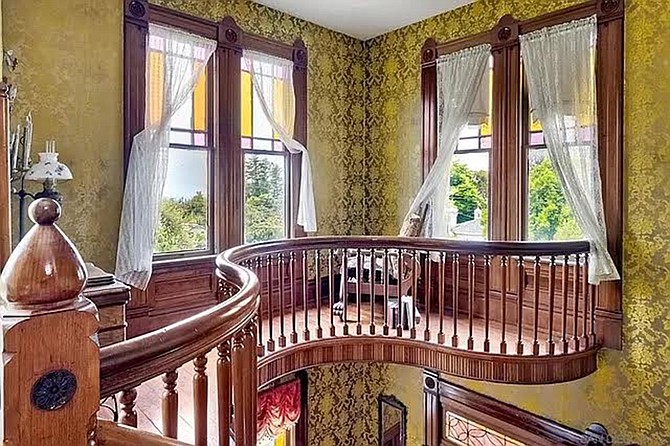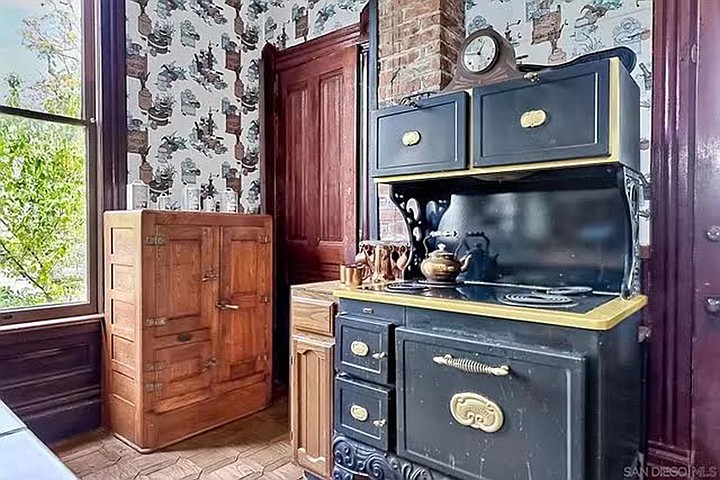 Facebook
Facebook
 X
X
 Instagram
Instagram
 TikTok
TikTok
 Youtube
Youtube

Is a 19th-century historical landmark in Carlsbad in danger of demolition?
Designated Landmark No. 4 by the city in 1986, the Culver-Myers-Capp house at 3140 Highland Drive was built by Alonzo Culver in 1888 “with the charm of a more genteel era,” according to its Zillow listing. Culver also built Carlsbad’s famous Twin Inns, a pair of Queen Anne Victorians on what’s now Carlsbad Boulevard, “borrowing” lumber hauled from Julian for that job to complete his own home. One of the twins was demolished in 1950; the other is still standing and incorporated into the Village Faire shopping mall.

“Thoughtfully positioned atop the highest elevation on this 1.27-acre ocean view lot, artfully accentuating its architectural detail,” the Culver mansion was originally part of a sprawling 30-acre parcel that incorporated several outbuildings, including a well house and blacksmith shop. In its early history, the house had a bit of a sordid reputation – Culver’s son Clinton was long rumored to have helped Chinese immigrants enter the country from Mexico illegally to work building California’s railroads, using the attic as a waystation en route to the grueling jobs. Clinton eventually served five years in prison on human smuggling charges.
David Harrington bought the estate in 1914, and his granddaughter Gertrude Myers, an artist known as the “Grandma Moses of Carlsbad,” lived there until 1965. After sitting vacant for several years, the house was purchased in 1969 by Kay and Gerald Capp, who undertook extensive renovations, restoring the original craftsmanship of the interior and (finally) installing an electrical system and indoor plumbing to replace the property’s outhouse.
Now, according to a March article in the Los Angeles Times, the home has once again fallen into disrepair. The family is reaching out to the city in hopes they’ll purchase and once again restore the home, but Carlsbad Historic Preservation Commission member Anne Estes said a recent visit showed “just squalid” conditions, and questioned the value of saving the house.
The home’s recent sale advertisement, however, paints a different picture entirely. “Upon entering, you’re taken back to a time where detail and quality materials mattered,” the listing gushes. “You’ll enjoy elaborate woodwork, dramatic stained glass, and a romantic widow’s walk with beautiful ocean views.” At first glance, the outside of the home does look a little drab, to be honest. Paint is peeling from the white-and-yellow wood siding, and the landscaping looks either barren or overgrown, depending on where you look. But that’s the exterior. “Details of every room are reminiscent of years gone by,” the listing continues. And indeed, the bleak groundskeeping is easily forgotten as you step into the rich wood entryway, its corner staircase adorned with intricately-carved balusters and antique stained-glass windows. A plaque commemorating the home’s historical designation is proudly displayed on a hutch. The living room has a grand fireplace with a similarly ornate mantle, wood-cased windows, exceptionally high ceilings, and what appear to be the original Julian pine floors, partially overlaid with a large rug.
Elaborate wallpapers generally don’t curry much favor with modern tastes, but they’re certainly in keeping with the mansion’s vintage. Whether yellow, blue, green floral or even plaid, paper adorns most of the walls inside, even the bathroom with its claw-foot tub. What we see of the kitchen is relatively spartan, even when considered in terms of a more modest home. A small counter and sink that seem more in sync with an early-1970s remodel than the original construction, and the stove looks so old that it might’ve once been powered by a wood fire (though it looks like there are now electric burners on the range top).
Upstairs is the interestingly curvaceous widow’s walk, along with four neatly-kept (if somewhat small) bedrooms. In the attic where Clinton Culver reportedly hid his trafficking victims from authorities, we see some water spotting, indicating a roof problem past or present, but that’s the visible extent of the squalor described by the preservation commissioner. “This home is rich in history with stories and legends dating back to the turn of the last century,” the listing concludes. “Owned and restored by three different families, this home is awaiting its next family to create memories for.”
In an indication that the bid to get the city to buy the property has either stalled or failed, the Culver-Myers-Capp estate was offered for sale to the general public by Capp’s heirs in mid-May. The asking price of $2,995,000 remains unchanged to date.


Is a 19th-century historical landmark in Carlsbad in danger of demolition?
Designated Landmark No. 4 by the city in 1986, the Culver-Myers-Capp house at 3140 Highland Drive was built by Alonzo Culver in 1888 “with the charm of a more genteel era,” according to its Zillow listing. Culver also built Carlsbad’s famous Twin Inns, a pair of Queen Anne Victorians on what’s now Carlsbad Boulevard, “borrowing” lumber hauled from Julian for that job to complete his own home. One of the twins was demolished in 1950; the other is still standing and incorporated into the Village Faire shopping mall.

“Thoughtfully positioned atop the highest elevation on this 1.27-acre ocean view lot, artfully accentuating its architectural detail,” the Culver mansion was originally part of a sprawling 30-acre parcel that incorporated several outbuildings, including a well house and blacksmith shop. In its early history, the house had a bit of a sordid reputation – Culver’s son Clinton was long rumored to have helped Chinese immigrants enter the country from Mexico illegally to work building California’s railroads, using the attic as a waystation en route to the grueling jobs. Clinton eventually served five years in prison on human smuggling charges.
David Harrington bought the estate in 1914, and his granddaughter Gertrude Myers, an artist known as the “Grandma Moses of Carlsbad,” lived there until 1965. After sitting vacant for several years, the house was purchased in 1969 by Kay and Gerald Capp, who undertook extensive renovations, restoring the original craftsmanship of the interior and (finally) installing an electrical system and indoor plumbing to replace the property’s outhouse.
Now, according to a March article in the Los Angeles Times, the home has once again fallen into disrepair. The family is reaching out to the city in hopes they’ll purchase and once again restore the home, but Carlsbad Historic Preservation Commission member Anne Estes said a recent visit showed “just squalid” conditions, and questioned the value of saving the house.
The home’s recent sale advertisement, however, paints a different picture entirely. “Upon entering, you’re taken back to a time where detail and quality materials mattered,” the listing gushes. “You’ll enjoy elaborate woodwork, dramatic stained glass, and a romantic widow’s walk with beautiful ocean views.” At first glance, the outside of the home does look a little drab, to be honest. Paint is peeling from the white-and-yellow wood siding, and the landscaping looks either barren or overgrown, depending on where you look. But that’s the exterior. “Details of every room are reminiscent of years gone by,” the listing continues. And indeed, the bleak groundskeeping is easily forgotten as you step into the rich wood entryway, its corner staircase adorned with intricately-carved balusters and antique stained-glass windows. A plaque commemorating the home’s historical designation is proudly displayed on a hutch. The living room has a grand fireplace with a similarly ornate mantle, wood-cased windows, exceptionally high ceilings, and what appear to be the original Julian pine floors, partially overlaid with a large rug.
Elaborate wallpapers generally don’t curry much favor with modern tastes, but they’re certainly in keeping with the mansion’s vintage. Whether yellow, blue, green floral or even plaid, paper adorns most of the walls inside, even the bathroom with its claw-foot tub. What we see of the kitchen is relatively spartan, even when considered in terms of a more modest home. A small counter and sink that seem more in sync with an early-1970s remodel than the original construction, and the stove looks so old that it might’ve once been powered by a wood fire (though it looks like there are now electric burners on the range top).
Upstairs is the interestingly curvaceous widow’s walk, along with four neatly-kept (if somewhat small) bedrooms. In the attic where Clinton Culver reportedly hid his trafficking victims from authorities, we see some water spotting, indicating a roof problem past or present, but that’s the visible extent of the squalor described by the preservation commissioner. “This home is rich in history with stories and legends dating back to the turn of the last century,” the listing concludes. “Owned and restored by three different families, this home is awaiting its next family to create memories for.”
In an indication that the bid to get the city to buy the property has either stalled or failed, the Culver-Myers-Capp estate was offered for sale to the general public by Capp’s heirs in mid-May. The asking price of $2,995,000 remains unchanged to date.